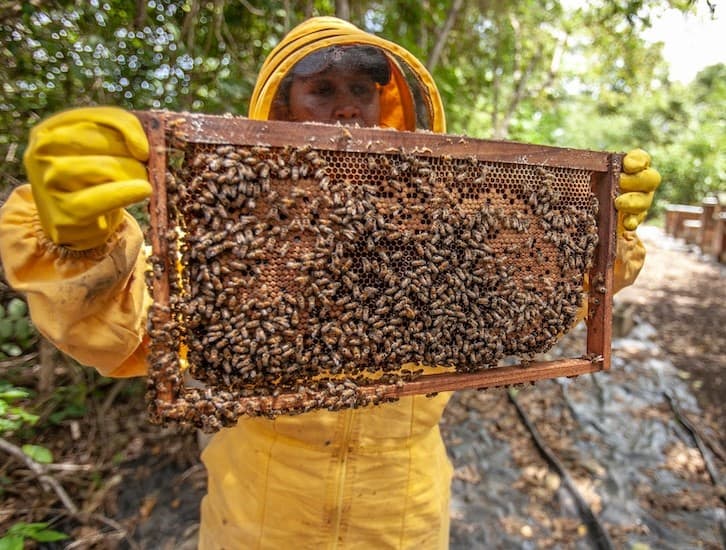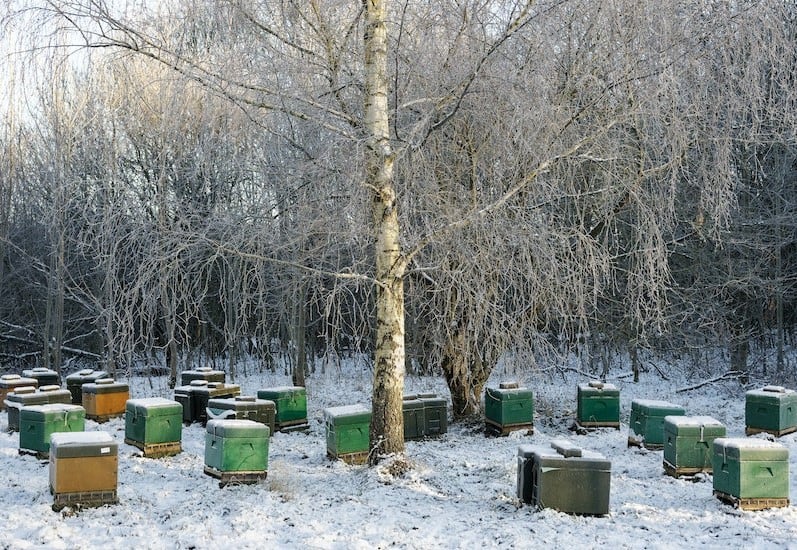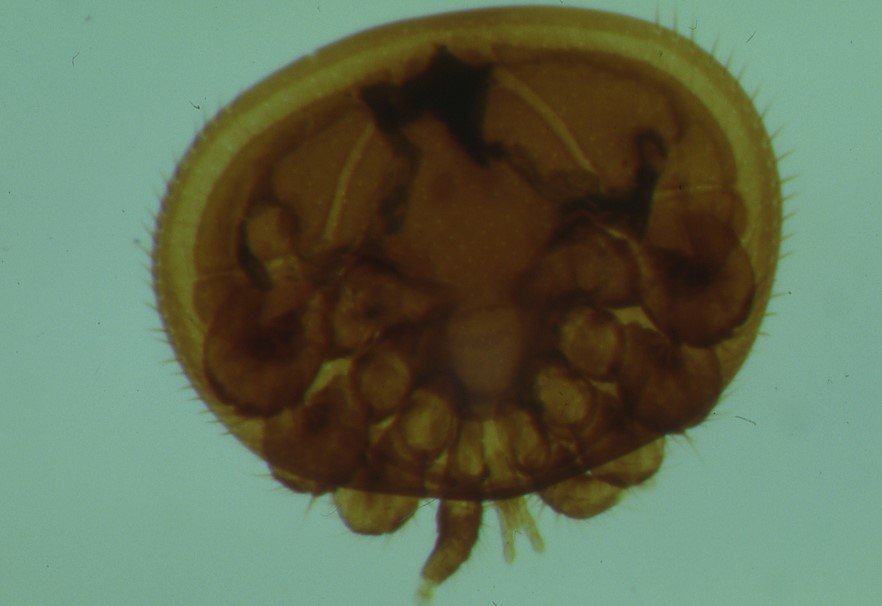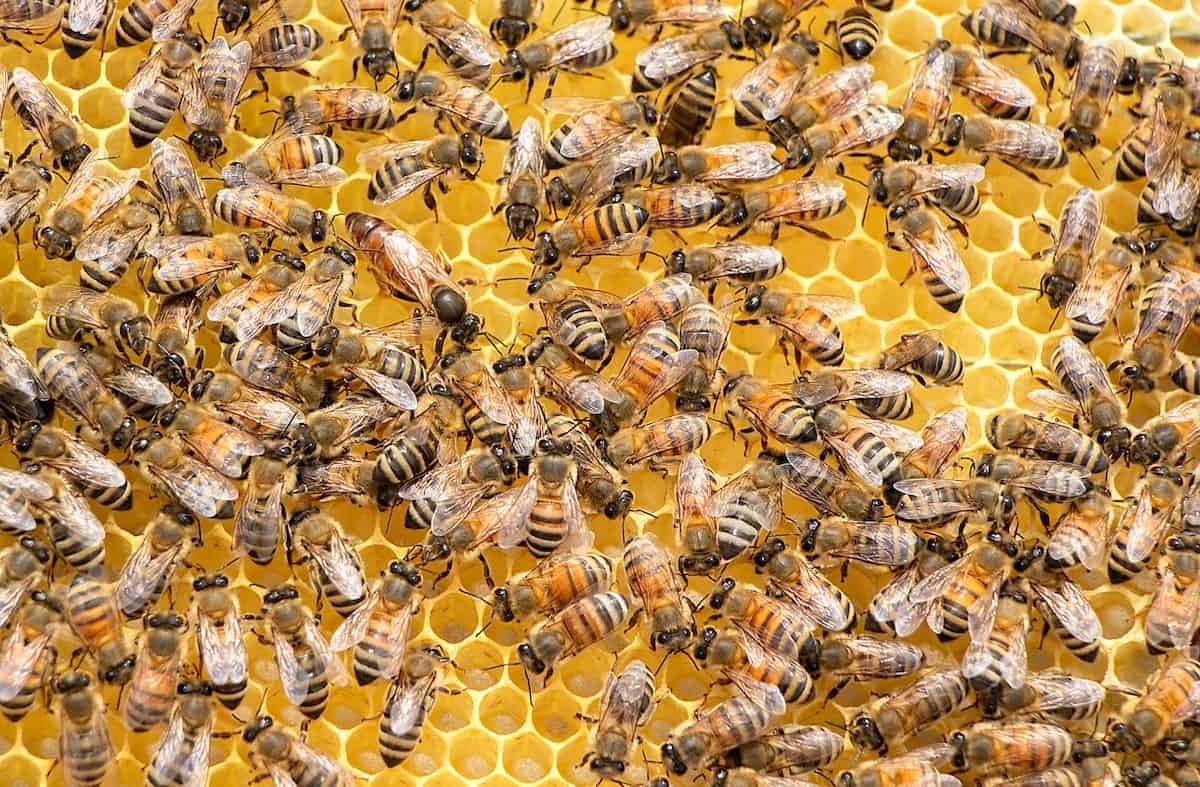Beekeeping has been fraught with bad news.
The battle against varroa wasn’t going so well for us. Colony collapse disorder has been wreaking havoc across the country. Beekeepers are going out of business, and the effect on our environment is yet to be fully understood.
Making chemical solutions seemed to be a good idea at first, but then we, the people, did what we always do. We abused them. We do it with cough syrup, painkillers, and now miticides.
So, the very pests we were looking to destroy became resistant to our chemicals and thrived in our beehives.
So, in 2004, we looked to Mother Nature to give us a solution, and it looks like she delivered with the Saskatraz bee.

What Are Saskatraz Bees?
Saskatraz bees are a new strain of bees that have been developed through the initiative of Dr. Albert Robertson in Saskatchewan, Canada. The breeding program was the result of the many research studies aimed at coming up with a strain of bees that produces high yields of honey as their primary objective.
The apiary is quite secluded, which helped maintain the results’ integrity. In addition to that, the bees found in Saskatchewan tend to make it through the winter successfully, which is an advantage for any beekeeper.
When they first started the project, the original colonies were wiped out by varroa infestation in two years. They then decided to introduce stock that is known for varroa tolerance.
Russian and German bees fit the bill quite nicely, so the Canadians collaborated with the Americans, and those particular bee races contributed to the project. This addition to the genetic pool proved to be very valuable in building resistance to the tracheal mite and tolerance to the varroa.
What resulted was the Saskatraz bees that we have come to know today.
Saskatraz Bees Pros and Cons
As with everything in life, there are pros and cons when it comes to Saskatraz Bees.
While many beekeepers appreciate their unique traits, there are certain factors to consider before deciding if they are the right choice for your hive.
Understanding both the advantages and potential challenges of raising Saskatraz Bees can help you make an informed decision.
Saskatraz Bee Pros
1. Prolific Honey Producers
Naturally, money would be the first motivator for the project. In the U.S., the Italian bees are known for being prolific and ideal for honey production.
Most commercial beekeepers prefer the Saskatraz breeder queen traits for that reason. Since the Saskatraz breeder queens are so great at their job, this race is also fantastic for pollination services.
Pollination is about the size of the colony rather than the number of colonies. The downside of the Italian bee race is that it doesn’t winter well. The Italian bees have more brood than they can care for as they go into winter, which leads us to the second characteristic of the Saskatraz Bee.
2. Queens Are Bred Without Chemical Miticides
Even though pharmaceutical intervention is initiated to solve a problem, it isn’t without its side effects. The chemicals we have used to fight these pests have negatively impacted our bees’ immunity system. They now succumb to every little virus that blows their way.
These bees have been bred by natural selection. They are stronger than most of the other bee races on offer. There’s a great shift toward the organic way of life, and breeding has not been left behind.
The Saskatraz hybrids have also been bred for their resistance to chalkbrood. Chalkbrood is caused when the bee larvae ingest the spores of a fungus called Ascosphaera apis.
If the colony is strong, the disease is manageable.
Colonies are vulnerable to the disease when temperatures drop. If you’re worried about the wintering ability of a colony, resistance to chalkbrood will be an added advantage to you.

3. Winter Survivors
The first milestone for every new beekeeper is getting their colonies through their first winter. Bees will either starve to death, freeze to death, or will be too sick to survive the winter.
Ideally, the bees will make enough honey in the fall to get them through the winter. If not, you will be courteous enough to leave some honey behind in the hive when you harvest to take care of their needs.
As a last resort, you will have to feed them with sugar syrup at first and then a candy board when the temperature really drops. Bees have been known to die between feeding sessions.
Sometimes, the cluster is too small to keep warm, and they die while surrounded by food. The colony needs to generate enough numbers to keep warm, but not so many that their stores aren’t enough. A genetic advantage in this area can be a definite advantage for the first year of beekeeping.

4. Varroa Tolerance
We all know that varroa tolerance and resistance to the same are two different things. If only this was resistance rather than tolerance. For now, tolerance is definitely a step up. Even today, breeders continue to look for ways to increase this trait in the Saskatchewan strain.
Fortunately, by adding Russian and German strains, they have bred bees in Saskatchewan that clean house. This reduces the need for chemical treatments and is good for the overall health of the colony.
Tolerance is evident as the worker bees show increased hygienic behavior. They are able to detect young adult bees that have been infested with mites. These are uncapped and expelled, controlling the mite population in the hive.
This increased varroa tolerance in these bees also makes the other treatment options, especially those that don’t involve chemical miticides, more effective.

Saskatraz Bee Cons
Despite how many pros we’ve discussed in this Saskatraz Bees review, there is one noteworthy disadvantage that you must consider.
1. Capital Intensive To Breed
This is not a bee race that you are likely to graft on your own. It requires a hefty investment in infrastructure, and the specialists you will need definitely don’t come cheap.
When you need to replace your queen, you will need to order one from a supplier, and there aren’t many of them available. That’s assuming you want to maintain that strain.
Wrapping Up Our Saskatraz Bees Review (Plus Helpful Video)
If you’re new to beekeeping, this will make for a great starter package. If you’re experienced, this would be a valuable addition to the apiary.
This video shows a beekeeper’s experience with this breed and mentions more positive characteristics and traits of the Saskatraz Bees. Seems like he’s just all praises.
You can learn a lot just by observing the behavior of these bees and comparing their output and resilience to disease against your other bee races. They may cost you a little more, but it is definitely a good investment.
And now, that’s a wrap about the Saskatraz Bees! We give this bee race two thumbs up!


As part of the natural selection no chemical treatment for varroa, does that include not using vaporized oxalic acid?
If I purchase these bees will I not need to use oxalic acid?
I have never used any treatments of any kind, no sugar water either, if they need to be fed, it is straight honey only. I have no issues. And that is with the normal bees raised organically. Want to see if these do any better. But treatment free is the only wY for me.
Agreed, Wayne, re treatment.
I don’t feed bees, either, but I have been warned about giving one hive honey from another, unless you know the honey producers are completely virus-free.
You will eventually lose all your bees from viruses if you do not keep mite numbers down
Who wrote this review? Good job
Kitty Kiefer
what are their traits for swarming, high or low?
This is my fist package of this breed, but I installed a package on May 6th is 8 frame. I added a box about the 1st week of June and today 1 July I had 2 swarm cells being drawn out with eggs inside and 1 capped. The next frame had 1 being drawn out, these were on the top deep. I didn’t have time to check the bottom so hopefully no more, but going to have to take a split off of them, the Queen is laying like crazy, great brood pattern. Hope this helps, and wish everyone a great rest of the season!
Mine swarmed their second year. I managed to catch the swarm fairly easily.
Excellent wright up. Thanks
WOW just what I was searching for. Came here by searching for google
Can you introduce a Saskatraz queen to an Italian hive?
@Brian – Yes. You can requeen with a different breed and the population will slowly turn over to the new breed as the new queens brood emerges. Just make sure that the old queen is no longer present, otherwise the Saskatraz queen will be killed.
I recently split a hive that consisted of a feral bees and introduced a Saskatraz queen to the spit from the main hive. The bees that I introduced the Saskatraz queen too, accepted the queen after a day. I kept her in the cage for an extra two days to make sure that there was not any problems, now she is laying. I tried with a Russian queen and they would not accept her at all. From my experience the Saskatraz is an easy queen to work with, and the bees are not aggressive.
Is it my imagination but the saskatraz bees look somewhat larger than the Carniolan bees. Is this true??
No
didn’t nsee an answer on oxalic treating will they still need it reply please
You must treat the bees with oxalic or formic like all the others. The only advantage is the problem with chalk brood, gone withing two years.
How resiliant are they to Wax Moths?
Timothy’s, wax moths are an opportunistic pest. If your colony is weak, they’ll move in because some frames will be left unguarded
Keep high bee population and it solves the problem.
Breeders don’t select for that trait.
All bees are resilient to wax moths unless you do not manage the hive properly and it becomes weak.
How do you keep a true sasktraz line? Because once the original queen dies,leaves whatever happens. They will start one, she will go on her mating flight and whatever drone is in a 2 or 3 mile area will try and mate her! So her brood that comes won’t be true sasktraz line, correct!!
Saskatraz are turning out to be no better than any other bee. They are just Russian hybrids. After the program got started they sent out breeder queens that are grafted and open mated and as a result you are getting a very diluted Russian bee. If you truly want a hearty winter bee start with a pure Russian queen and raise your own queens from her. ALL bees need to be treated for mites!
Hello
I have been beekeeping for 24 years. Of course, I live next to my main job as a teacher in Iran and in a village in Shiraz. I invite you to be our guest.
I have tried different races. I was very successful with the Katernica race. Friends suggested Saskatchewan. I assigned 5 colonies to this sample and I am reviewing the results. I have not finished the work yet, but I am satisfied so far.
I used the contents of this site.
Hello
I have been beekeeping for 24 years. Of course, next to the main job is being a teacher. I live in Iran and in a village in Shiraz. I invite you to be my guest.
I have tried different races. I was very successful with the Karnika race. My friends suggested Saskatchewan, I assigned 5 colonies to this sample and I am reviewing the results, I have not finished yet, but I am satisfied so far.
I used the contents of this site.
Has anyone had experience with a Saskatraz queen laying outside the cells? I installed a new package 10 days ago. I checked for eggs/larva at 1 week and found non, then again yesterday… and found none again. I finally found the unmarked queen and observed her with eggs sticking out her south end… then they’d drop off as she walked but she wasnt going into cells or laying in cells at all. Has anybody experienced that before? If so, did your queen get her act together or did you replace her??
One thing that I have noticed when adding a Saskatraz queen to a hive split off of feral bees is the smaller size of the queen. I may have a strain of Italian bees, because of their gentile nature, but hope that the Saskatraz queen introduction does not make them more aggressive. I really like the feral bees, that I did a cut out to get, because of the way I can get into the hive and examine it without smoking or wearing a bee suit. Every now and then I get a bee that makes me back off away from the hive, are the Saskatraz a little more aggressive? and does that make them better honey producers?
I have been keeping strictly Saskatraz for the past 4 years in 20 hives. They can be rather gentle on perfect days. However, they can be a bit testy. They are not aggressive by any means but can be defensive. For example, they will readily come let me know I’m too close but leave my wife and children alone. They don’t even buzz or head butt other people who visit my apiary.
I have extremely good winter survival rates, in the 90% – 100% range every year. I honestly think this is mainly due to the genetics and partly how I work them. I do treat for mites and I have noticed that their mite counts are always lower than others in my area. The state inspector actually pointed this out to me and asked what genetics I was using. In the fall they do have to be treated for mites to help them keep the numbers low.
They can bit a little slow on the spring build up however, they do produce a good honey crop. Not the heaviest producers but they make good quality honey. I honestly don’t know why this is. There is another apiary down the road from me. Probably about 2 miles and the honey from the Saskatraz is drastically different (Lighter and has a very floral taste) but the flowers and foliage are the same in both areas.
I highly recommend the strain.
Its like 2 chefs in 2 different kitchens but whent to the same school and the work both different
This is the first year I have been keeping Saskatraz bees. I think they are great bees and have done ready well in their first year. One thing I am noticing though as I am getting ready for winter is that there is a lot of brood still.
Is it common for Saskatraz queens to still lay a lot of brood later in the season?
I just are reading about beekeeping so I was thinking about to look for a hive here but after looking a little I found that there is Saskatraz bees so I m hoping that I can buy them and bring them over to Belgium and start with this bee here .
I hope that I get a answer fast about what happens when they bred with bees from here
I live in southwest Colorado and have been a “bee host” for three years now. I am also a co founder of our community apiary. Winters are cold here and our honeybee survival rate has been low. I have not been able to find a saskatraz supplier in our area. Any advice is most welcome. We have had both Italian and carnelian (sp?).
Saskatraz bees are being bred in California by a commercial queen rearing outfit. The season starts too late in Saskatchewan to raise queens for the spring market. Look there.
Vicki,
You can find Saskatraz shipped to CO from https://www.mannlakeltd.com/honey-bees/ohb-saskatraz-package-bees-shipped/
this was good!!!!!!!!
How do Saskatraz bees do in south Texas (thinking about the heat here)?
They raise this breed in Orland California where it is often over 100 plus degrees for several days at a time.